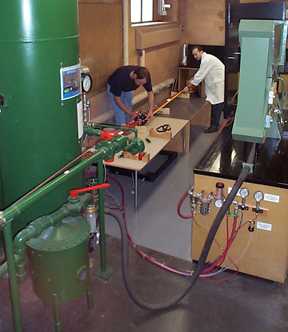Cold Flow Rocket Motor Simulator Shock Nozzle Interaction Study

The impingement of an axial shock wave on a choked nozzle, or a motor head end congifuration, and the resulting transient transverse wave development and separation of the boundary layer, is of interest in the evaluation of unsteady rocket motor operation. The CFRMS/SNIS is being used as a means of gaining experimental information that might be used in conjunction with CFD simulation results. While the base pressure and temperature of the internal gas (in this case, air) is considerably lower in this experiment versus that for a gas in a solid, hybrid or liquid rocket engine, there may be number of flow parameters that can be correlated between the two cases. One or more suitably positioned high-frequency pressure transducers provide the required experimental data (incident and reflected shock wave profile with time). Various nozzle designs can be tested, as well as various head end geometric configurations. Correlation to potential problems with actual rocket motor designs can then be made.